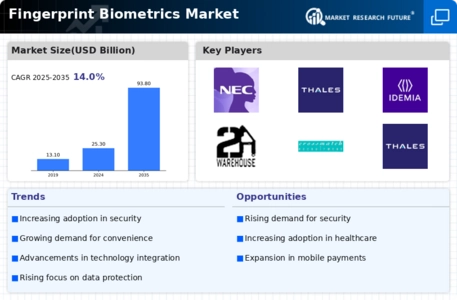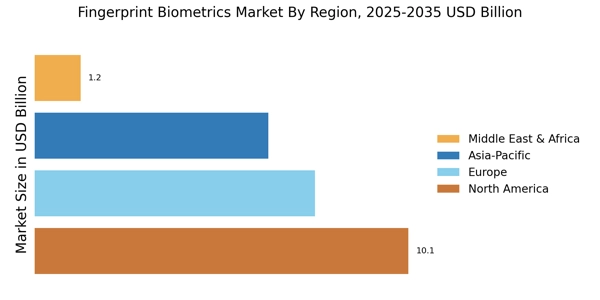Leading market players are investing heavily in research and development in order to expand their product lines, which will help the Fingerprint Biometrics Market grow even more. Market participants are also undertaking several strategic activities to spread their footprint, with important market developments including contractual agreements, new product launches, mergers and acquisitions, higher investments, and collaboration with other organizations. To spread and sustain in a more competitive and rising market climate, the Fingerprint Biometrics industry must offer cost-effective items.
Manufacturing locally to minimize operational costs is one of the prime business tactics used by the manufacturers in the Fingerprint Biometrics industry to benefit the clients and grow the market sector. In recent years, the Fingerprint Biometrics industry has offered some of the most significant advantages to several industries. Major players in the Fingerprint Biometrics Market, including NEC Corporation, Safran S.A., Thales Group, Idemia, Cognitec Systems GmbH, Aware, Inc., BIO-key International, Inc., Crossmatch (acquired by HID Global), Fujitsu Limited, Gemalto (acquired by Thales Group), and others, are trying to raise market demand by investing in the research and development operations.
BIO-Key International Inc. is a leading provider of biometric authentication solutions. Specializing in fingerprint recognition technology, the company offers secure and convenient authentication solutions for enterprises, government agencies, and consumers. With a focus on enhancing cybersecurity and user experience, BIO-Key's solutions cater to diverse industries, including healthcare, finance, and law enforcement. The company's innovative approach to biometric authentication has positioned it as a key player in the evolving landscape of digital security.
In March 2023, BIO-Key International Inc. partnered with Ethnos IT Solutions in order to bring innovative IAM solutions to customers across Africa who are looking to improve their cybersecurity with enhanced access security and seamless user experiences.
Thales Group is a multinational company specializing in aerospace, defense, and technology solutions. With a rich history dating back to 1893, Thales has established itself as a leading provider of innovative technologies and services across various industries, including transportation, security, and digital identity management. The company's offerings range from cybersecurity and communication systems to advanced avionics and satellite technology, serving both government and commercial clients worldwide. Thales is known for its commitment to research and development, driving advancements in critical areas such as data analytics, artificial intelligence, and digital transformation.
In October 2023, Thales launched a new biometrics smart card for enterprise access control. The SafeNet IDPrime FIDO Bio Smart Card features an embedded fingerprint sensor and NFC capabilities and is focused on security access to both IT assets and physical venues.


















Leave a Comment